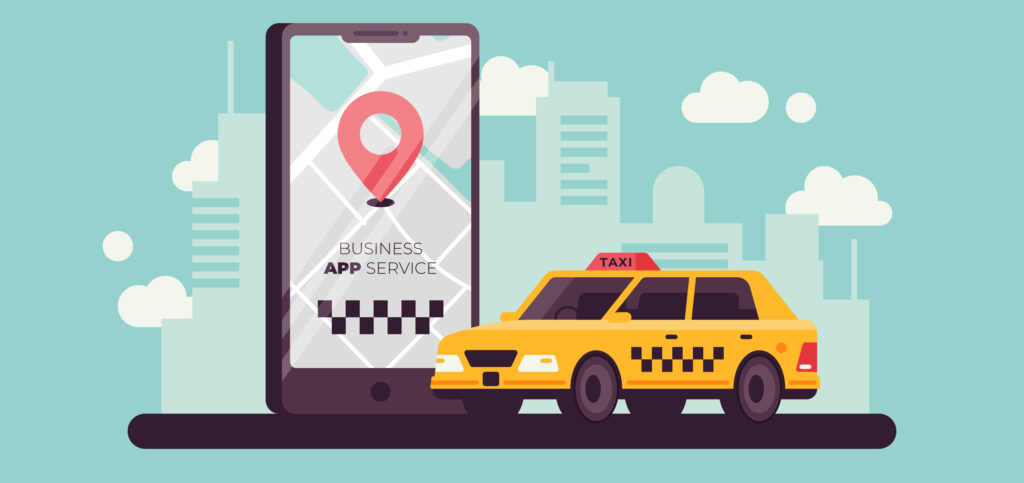The introduction of taxi booking software has drastically altered the urban transportation scene. Thanks to this cutting-edge software, people no longer need to stand on corners and hail cabs; they can instead simply request a ride with a few taps on their phones. Not only does taxi booking software make it easy for riders to book rides, but it also helps drivers keep track of their time and passengers.
Key Features To Include In Taxi Booking Software
There are certain features that are crucial for ensuring a seamless, efficient, and user-friendly experience for your taxi booking software. Below is a comprehensive list of key features:
For Passengers
User Registration/Login: Allows users to register and create a personal account.
Booking Interface: A simple and intuitive interface for booking a ride. Users should be able to enter pick-up and drop-off locations, select vehicle types, and see fare estimates.
Fare Calculator: Provides an estimated cost for the ride based on distance, traffic, surge pricing, and other factors.
Driver Details: Displays information about the driver and vehicle, including name, photo, vehicle model, and ratings.
Live Tracking: Enables passengers to track the driver’s location in real-time from pickup to drop-off.
Payment Integration: Offers multiple payment options including credit/debit cards, mobile wallets, and in some cases, cash.
Rating and Review System: Allows passengers to rate their ride experience and provide feedback to improve the system.
Ride History: Keeps a record of past rides, including dates, routes, and fares, for easy access and reference.
Customer Support: Provides in-app support for resolving issues, reporting lost items, or addressing safety concerns.
For Drivers
Driver Registration/Login: Facilitates drivers to sign up, submit necessary documents, and create their profile.
Ride Alerts: Notifies drivers of ride requests with details like accept/reject ride, location, destination, and fare estimate.
Navigation and Route Optimization: Integrates with GPS and maps for the best routes in real-time, considering current traffic conditions.
Earnings Tracker: Allows drivers to track their earnings, rides, and performance metrics.
Ride History: Maintains a log of completed, cancelled, and upcoming rides.
Rating and Feedback: Enables drivers to view their ratings and receive feedback from passengers.
Admin Backend
Dashboard: Provides a comprehensive overview of real-time operations, including active rides, total earnings, number of users, and more.
Driver Management: Tools to manage driver profiles, documents, and status (approved, pending, rejected).
Passenger Management: Enables the admin to view and manage passenger accounts and activity.
Fare Management: Allows for the adjustment of base fares, surge pricing, and other charges.
Analytics and Reporting: Generates detailed reports on rides, earnings, user demographics, and feedback for informed decision-making.
Customer Support Module: Facilitates handling of user queries, complaints, and feedback.
Additional Features
Push Notifications: Sends timely alerts about ride status, promotions, and other relevant information.
In-app Chat or Call: Allows communication between passengers and drivers within the app for better coordination.
Emergency/SOS Button: Enhances safety by enabling users to send an immediate alert in case of emergencies.
Loyalty Programs: Rewards frequent users with discounts, offers, or points to encourage loyalty.
Step By Step Process Of Taxi Booking Software Development
Developing a taxi booking software involves a series of systematic steps, as detailed below:
Market Research and Analysis
Identify Target Audience: Understand who your users are (drivers and passengers) and what they need.
Competitor Analysis: Study existing taxi booking softwares to identify what works and what could be improved.
Feature List Creation: Based on your research, create a list of must-have and nice-to-have features for your app.
Define Business Model
Revenue Streams: Decide on how your app will generate revenue – through commissions, surge pricing, subscription models, in-app advertisements, etc.
Operational Model: Choose whether you’ll operate on an aggregator model (connecting passengers with driver-partners) or own a fleet.
UI/UX Design
Wireframing: Sketch the basic structure of your app’s screens and flow.
Prototype Development: Create a clickable prototype to visualise the user experience.
UI Design: Design the user interface, focusing on aesthetics, branding, and usability.

Choose the Right Technology
Frontend Development: Decide on the technologies for iOS and Android app development (e.g., Swift for iOS, Kotlin for Android) or a cross-platform solution (e.g., Flutter, React Native).
Backend Development: Choose a robust backend technology (e.g., Node.js, Ruby on Rails) that can handle real-time data processing and scalability.
Database: Select a database that supports scaling and real-time updates (e.g., MongoDB, Firebase).
App Development
Frontend and Backend Development: Start the coding process, developing both the client-side and server-side parts of your app.
API Integration: Integrate third-party APIs for functionalities like payments, maps, and SMS notifications.
Testing: Conduct thorough testing, including unit tests, integration tests, and user acceptance testing (UAT) to ensure the app is bug-free and user-friendly.
Legal Considerations
Compliance: Ensure your app complies with local regulations concerning transportation services.
Privacy Policy and Terms of Use: Draft clear privacy policies and terms of use to protect your company and inform users.
Launch
Beta Testing: Before the official launch, conduct beta testing with a select group of users to gather feedback and make necessary adjustments.
Launch Strategy: Develop a marketing and launch strategy to create buzz and attract initial users.
App Store Submission: Submit your app for review and publication on the App Store and Google Play.
Post-Launch Activities
Marketing and Promotion: Continue with your marketing efforts to attract new users and retain existing ones.
User Support: Set up a system for customer support to handle queries and complaints.
Monitoring and Analytics: Use analytics tools to monitor app performance, user engagement, and other key metrics.
Continuous Improvement: Based on user feedback and performance data, regularly update the app with new features, improvements, and bug fixes.
Best Taxi Booking Software Development Company
Appscrip offers a comprehensive taxi booking app solution equipped with various features to streamline the taxi booking process for passengers, drivers and admins. Here are some key features included in Appscrip’s taxi booking app:
Book multiple drop-offs: Customers can arrange for numerous drop-offs throughout the course of a single pickup, and they can even add stops to their route once it has begun moving.
Surge Pricing: Establish zone-specific and vehicle-specific surge pricing.
Book for Someone Else: Anyone can easily arrange and pay for a ride for a friend or family member, and they can even get a link to monitor their journey by email or text message.
Live Track Drivers: See the drivers’ whereabouts and estimated times of arrival (ETA) on a map in real time whenever you need them.
Special Pickup Points: In places with several gates, such as an airport or a shopping mall, the admin can set up specific pickup spots so that customers can tell drivers exactly where to meet them.
App Wallet: With Wallet, users can easily fund their app-integrated wallet and make payments with a single tap.
Various Payment Methods: Payment options for users include a variety of credit/debit cards, cash, loyalty points, and a cash wallet.
Discount Codes: Customers can buy more with less when they use discount codes. These can be used before or during a journey.
Queue Dispatch: Automated dispatch systems at airports and similar venues use first-in, first-out (FIFO) dispatch to allocate trips to drivers.

Minimise Google Maps Expenditure: We have reduced our reliance on Google Maps by implementing open-source mapping for reverse geocoding, route optimization, ETA, and distance calculation.
Optimising Routes: To maximise billable miles, the software optimises routes so drivers spend as little time as possible deadheading during pickups.
New Trip before Completion: If there are no available drivers, the dispatcher might choose to distribute trip requests to drivers who are almost finished with their current trip.
Driver Rewards Programs: Key performance indicators (KPIs) such as acceptance rate, average rating, duty time, and total earnings can be used to incentivize drivers.
Driver Compensation: Earning reports are automatically generated, and drivers have the option to get paid straight from the software.
Module for Fleet Owners: A dashboard is available to fleet owners for the management of drivers and vehicles. On the platform, they can accept bookings by adding their fleet.
Supervise Cars and Drivers: The administrator can keep track of drivers’ and vehicles’ documentation, and the system will suspend or notify them when a critical transportation document expires.
Managing Fares in Real Time: The fare can be configured city-by-city and vehicle-by-vehicle, and it factors in waiting time, distance travelled, and journey time.
Driver Reviews and Ratings: Key performance indicators (KPIs) are essential for managing driver incentives and performance, and customers have the option to assess and review drivers after each journey.
Trip Security System: This system makes sure that the correct driver is picking up the customer by generating a unique 4-digit code that the consumer must share with the driver before the trip can begin.
Driver Preferences: Customers have the option to specify if they require a wheelchair-accessible vehicle, a male or female driver, etc.
Driver Dashboard: The driver dashboard page allows drivers to see their earnings and performance data weekly.
Conclusion
With the growing reliance on digital solutions for transportation, launching a taxi booking software can significantly enhance the user experience, streamline operations, and open up new revenue streams for businesses.
Navigating the complexities of taxi booking software development requires expertise and experience. This is where Appscrip comes into play. With a comprehensive suite of taxi booking software development solutions, Appscrip empowers businesses to launch their custom taxi booking softwares efficiently and effectively.
Our team of experts specialises in crafting apps that are not only visually appealing but also functionally robust, scalable, and user-friendly. Whether you’re aiming to revamp an existing transportation service or launch a groundbreaking new app, Appscrip’s tailored solutions can help you achieve your goals.










